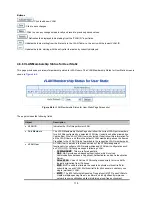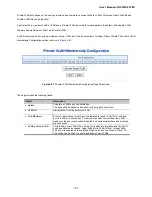
108
4.6 VLAN
4.6.1 VLAN Overview
A Virtual Local Area Network (VLAN)
is a network topology configured according to a logical scheme rather than the physical
layout. VLAN can be used to combine any collection of LAN segments into an autonomous user group that appears as a single
LAN. VLAN also logically segment the network into different broadcast domains so that packets are forwarded only between
ports within the VLAN. Typically, a VLAN corresponds to a particular subnet, although not necessarily.
VLAN can enhance performance by conserving bandwidth, and improve security by limiting traffic to specific domains.
A VLAN is a collection of end nodes grouped by logic instead of physical location. End nodes that frequently communicate with
each other are assigned to the same VLAN, regardless of where they are physically on the network. Logically, a VLAN can be
equated to a broadcast domain, because broadcast packets are forwarded to only members of the VLAN on which the broadcast
was initiated.
1.
No matter what basis is used to uniquely identify end nodes and assign these nodes VLAN
membership, packets cannot cross VLAN without a network device performing a routing
function between the VLAN.
2.
The Managed Switch supports IEEE 802.1Q VLAN. The port untagging function can be used to
remove the 802.1 tag from packet headers to maintain compatibility with devices that are
tag-unaware.
3.
The Switch's default is to assign all ports to a single 802.1Q VLAN named DEFAULT_VLAN. As
new VLAN is created, the member ports assigned to the new VLAN will be removed from the
DEFAULT_ VLAN port member list. The DEFAULT_VLAN has a VID = 1.
This section has the following items:
IEEE 802.1Q VLAN
Enable IEEE 802.1Q Tag based VLAN group
IEEE 802.1Q Tunneling
Enables 802.1Q (QinQ) Tunneling
Private VLAN
Creates/removes primary or community VLANs
4.6.2 IEEE 802.1Q VLAN
In large networks, routers are used to isolate broadcast traffic for each subnet into separate domains. This Managed Switch
provides a similar service at Layer 2 by using VLANs to organize any group of network nodes into separate broadcast domains.
VLANs confine broadcast traffic to the originating group, and can eliminate broadcast storms in large networks. This also
provides a more secure and cleaner network environment.
An IEEE 802.1Q VLAN is a group of ports that can be located anywhere in the network, but communicate as though they belong
to the same physical segment.
VLANs help to simplify network management by allowing you to move devices to a new VLAN without having to change any
physical connections. VLANs can be easily organized to reflect departmental groups (such as Marketing or R&D), usage groups
Summary of Contents for IFS NS3550-24T/4S
Page 1: ...P N 1072569 REV 00 05 ISS 11OCT12 IFS NS3550 24T 4S User Manual ...
Page 37: ...User s Manual of NS3550 24T 4S 37 ...
Page 96: ...96 Figure 4 4 6 Port Mirror Configuration Page Screenshot ...
Page 127: ...User s Manual of NS3550 24T 4S 127 Figure 4 6 10 Port 1 Port 6 VLAN Configuration ...
Page 184: ...184 Figure 4 9 14 Voice VLAN Configuration Page Screenshot ...
Page 204: ...204 Figure 4 11 4 Network Access Server Configuration Page Screenshot ...
Page 234: ...234 Figure 4 12 1 Port Limit Control Configuration Overview Page Screenshot ...
Page 250: ...250 Click to undo any changes made locally and revert to previously saved values ...
Page 297: ...User s Manual of NS3550 24T 4S 297 ...
Page 388: ...388 Example Show RADIUS statistics SWITCH security aaa statistics ...
Page 410: ...410 Parameters vid VLAN ID 1 4095 Default Setting disable ...
















































